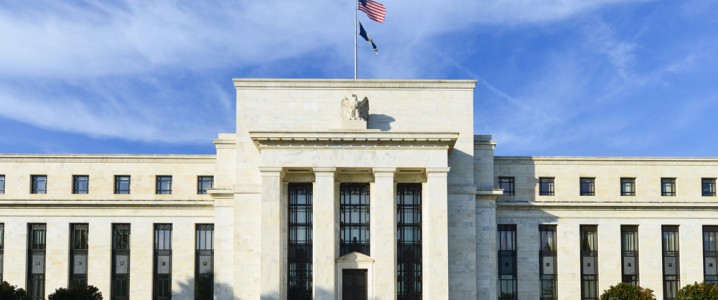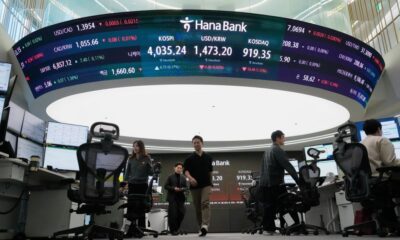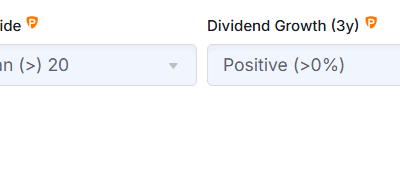Business
Dollar Gains Slightly as Markets Anticipate Fed Rate Cuts

The U.S. dollar registered slight gains in early Asian trading on Monday as it attempted to recover from a four-week low against the euro. This movement follows comments from Federal Reserve Chair Jerome Powell, who indicated a potential shift towards interest rate cuts. The dollar rose by 0.2% to $1.1699 per euro, although it remained close to Friday’s low of $1.1742, marking its weakest level since late July.
In other currency exchanges, the dollar increased by 0.1% to $1.3502 against the British pound after a significant decline of 0.8% in the previous session. It also gained 0.4% to 147.46 yen, recovering part of Friday’s 1% drop. The risk-sensitive Australian dollar briefly reached a one-week high of $0.6523 before retracting to $0.6484.
Market Expectations Shift Following Powell’s Remarks
Despite these modest gains, the dollar continues to face substantial pressure in light of Powell’s speech at the Federal Reserve’s annual Jackson Hole symposium. During his address, he warned of increasing downside risks to employment and signaled the possibility of a rate cut at the upcoming policy meeting on September 17. Current market forecasts indicate an approximately 80% likelihood of a quarter-point cut next month, with expectations of nearly half a percentage point in reductions by the end of the year, according to data from LSEG.
The Fed’s shift in tone occurs amidst mixed signals from the U.S. economy, including a disappointing payrolls report and unexpectedly high inflation and business activity figures. Analysts from Goldman Sachs noted that the future pace and extent of rate cuts will depend largely on forthcoming data. Key economic indicators to watch include the Fed’s preferred inflation gauge, the PCE deflator, which will be released on Wednesday, and the August payrolls data scheduled for next Friday.
Political dynamics are also influencing the Federal Reserve’s actions. President Donald Trump has intensified his criticism of Powell and other Fed officials, recently targeting Fed Governor Lisa Cook regarding her personal mortgage holdings. This rhetoric raises concerns about the independence of the Federal Reserve, adding another layer of uncertainty for market participants.
Implications for Oil Prices and Economic Growth
For oil traders, the weakening dollar presents a mixed scenario. Generally, a softer dollar boosts crude prices by making dollar-denominated oil cheaper for foreign buyers. This trend could lead to short-term price increases if the dollar continues to weaken due to dovish Fed expectations. Conversely, Powell’s warning about rising employment risks suggests a more fragile economic outlook. If labor market weaknesses deepen and economic growth slows, oil demand could face pressure later this year.
The Fed’s decision in September will have significant repercussions not only for currency markets but also for global energy consumption patterns. In the short term, crude prices may find support from the dollar’s weakness, but traders are closely monitoring incoming inflation and payrolls data. A rate cut that effectively stabilizes growth could support oil demand, while signs of economic downturn could limit price rallies.
As of the latest figures, West Texas Intermediate (WTI) crude traded at $63.74, while Brent crude was priced at $67.77. The upcoming economic indicators will be crucial in shaping the outlook for both currency and oil markets in the near future.
-

 Politics4 weeks ago
Politics4 weeks agoSecwepemc First Nation Seeks Aboriginal Title Over Kamloops Area
-

 World5 months ago
World5 months agoScientists Unearth Ancient Antarctic Ice to Unlock Climate Secrets
-

 Entertainment5 months ago
Entertainment5 months agoTrump and McCormick to Announce $70 Billion Energy Investments
-

 Science5 months ago
Science5 months agoFour Astronauts Return to Earth After International Space Station Mission
-

 Lifestyle5 months ago
Lifestyle5 months agoTransLink Launches Food Truck Program to Boost Revenue in Vancouver
-

 Technology3 months ago
Technology3 months agoApple Notes Enhances Functionality with Markdown Support in macOS 26
-

 Lifestyle3 months ago
Lifestyle3 months agoManitoba’s Burger Champion Shines Again Amid Dining Innovations
-

 Top Stories2 months ago
Top Stories2 months agoUrgent Update: Fatal Crash on Highway 99 Claims Life of Pitt Meadows Man
-

 Politics4 months ago
Politics4 months agoUkrainian Tennis Star Elina Svitolina Faces Death Threats Online
-

 Sports5 months ago
Sports5 months agoSearch Underway for Missing Hunter Amid Hokkaido Bear Emergency
-

 Politics5 months ago
Politics5 months agoCarney Engages First Nations Leaders at Development Law Summit
-

 Technology5 months ago
Technology5 months agoFrosthaven Launches Early Access on July 31, 2025





















